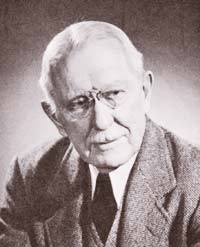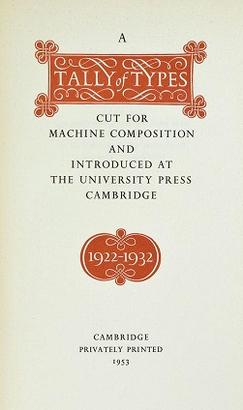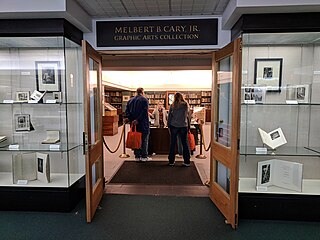Related Research Articles

Garamond is a group of many serif typefaces, named for sixteenth-century Parisian engraver Claude Garamond, generally spelled as Garamont in his lifetime. Garamond-style typefaces are popular and particularly often used for book printing and body text.
The Colophon, subtitled A Book Collectors' Quarterly or A quarterly for booklovers, was a limited edition quarterly periodical begun late in 1929 and continuing in various guises until 1950. It was the brainchild of Elmer Adler (1884–1962), founder of Pynson Printers of New York City. His idea was that various printers around the world would be willing to contribute their time and expertise to produce signatures (articles) using their own choice of papers, typography and illustration. These articles would then be bound together in boards by Pynson Printers and marketed to 2,000 subscribers.

Frederic William Goudy was an American printer, artist and type designer whose typefaces include Copperplate Gothic, Goudy Old Style and Kennerley. He was one of the most prolific of American type designers and his self-named type continues to be one of the most popular in America.

William Addison Dwiggins, was an American type designer, calligrapher, and book designer. He attained prominence as an illustrator and commercial artist, and he brought to the designing of type and books some of the boldness that he displayed in his advertising work. His work can be described as ornamented and geometric, similar to the Art Moderne and Art Deco styles of the period, using Oriental influences and breaking from the more antiquarian styles of his colleagues and mentors Updike, Cleland and Goudy.

Alfred A. Knopf, Inc. is an American publishing house that was founded by Blanche Knopf and Alfred A. Knopf Sr. in 1915. Blanche and Alfred traveled abroad regularly and were known for publishing European, Asian, and Latin American writers in addition to leading American literary trends. It was acquired by Random House in 1960, and is now part of the Knopf Doubleday Publishing Group division of Penguin Random House which is owned by the German conglomerate Bertelsmann.
Norman Thompson Aeisler Munder (1867–1953) was a printer and typographer, and a pioneer in modern printing.

William Henry Bradley was an American Art Nouveau illustrator, artist and film director. Nicknamed the "Dean of American Designers" by The Saturday Evening Post, he was the highest-paid American artist of the early 20th century.

Beatrice Lamberton Warde was a twentieth-century writer and scholar of typography. As a marketing manager for the British Monotype Corporation, she was influential in the development of printing tastes in Britain and elsewhere in the mid-twentieth century and was recognized at the time as "[o]ne of the few women typographers in the world". Her writing advocated higher standards in printing, and championed intelligent use of historic typefaces from the past, which Monotype specialised in reviving, and the work of contemporary typeface designers.
Frederic Warde was a book designer, editor, and typography designer. One of the great book designers of the twentieth century, Will Ransom described him as "a curious blend of romantic idealism and meticulous practicality." In describing his own work, Warde stated, "The innermost soul of any literary creation can never be seen in all its clarity and truth until one views it through the medium of the printed page, in which there must be absolutely nothing to divide the attention, interrupt the thought, or to offend one's sense of form."

Goudy Old Style is an old-style serif typeface originally created by Frederic W. Goudy for American Type Founders (ATF) in 1915.

Bruce Rogers was an American typographer and type designer, acclaimed by some as among the greatest book designers of the twentieth century. Rogers was known for his "allusive" typography, rejecting modernism, seldom using asymmetrical arrangements, rarely using sans serif type faces, often favoring faces such as Bell, Caslon, his own Montaigne, a Jensonian precursor to his masterpiece of type design Centaur. His books can fetch high sums at auction.

Print is an American design and culture website that began as Print, A Quarterly Journal of the Graphic Arts, in 1940, and continued publishing a physical edition through the end of 2017 as Print.
The Print Collector's Quarterly, was a quarterly periodical that was begun in 1911 and continued under various publishers until 1950. The original founders were art dealer Frederick Keppel and art historian, Fitzroy Carrington.

John Stroble Fass was an American graphic designer and a printer of fine press books. Fass designed books for the leading American publishers of limited edition books. Collectors of private press books also remember John Fass for the handcrafted books he printed on a tabletop printing press in his one-room apartment at the Bronx YMCA. Fass' books and his photography celebrate his life in New York City, where he lived most of his career. His work also documents his passion for the rural landscapes of his native Lancaster County, Pennsylvania.
Paul Johnston was among the printers and artists who defined a new American style of printing, typography and book design in the 1920s and 1930s.

A Tally of Types is a book on typography authored by the type designer Stanley Morison. It was first published in 1953, and showcases significant typeface designs produced during Morison's tenure at the Lanston Monotype Corporation for their hot-metal typesetting machines during the 1920s and 1930s in England.

The Cary Graphic Arts Collection is a library and archive of books, type specimens, manuscripts, documents, and artifacts related to the history of graphical communication. Located in Wallace Library at the Rochester Institute of Technology (RIT), in Henrietta, New York, the Cary Collection contains literate artifacts as old as cuneiform tablets and as recent as computer tablets and e-books, in all comprising some 40,000 volumes in addition to manuscripts, correspondence, printing types and traditional letterpress printing equipment.
Oak Knoll is a bookseller and publisher based in New Castle, Delaware, United States. Oak Knoll includes Oak Knoll Books which specializes in the sale of rare and antiquarian books and Oak Knoll Press which is a publisher and distributor of in-print titles. Both divisions specialize in "books about books" on topics such as printing history, bibliography, and book arts. Oak Knoll has also been the sponsor of the book arts festival Oak Knoll Fest.
Edna Rudolph Beilenson (1909–1981) was an American typographer, fine press printer, typesetter, book designer, cook book author, publisher, and co-proprietor of the Peter Pauper Press from 1931 until his death in 1962, and afterward its sole proprietor and president until her death in 1981.
References
- ↑ Printing and the Renaissance, John Rothwell Slater, 1921. The company name is on the title page and last page. Internet Archive.
- ↑ "Preliminary Guide to the William Edwin Rudge Collection".
- ↑ Nipps, Karen (2005). "The Cover Design". The Library Quarterly: Information, Community, Policy. 75 (3): 372–374. doi:10.1086/497313. ISSN 0024-2519.
Printer-Farmer-Publisher Print, A Quarterly Journal of the Graphic Arts 1943 Sept Vol 3, Part 3, p25 by Rudge - the gist of the article describes some of the economic difficulties in publishing the journal during wartime conditions.